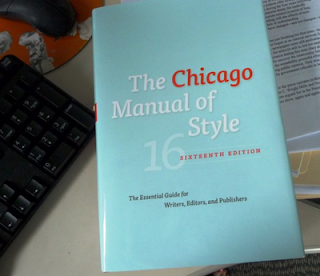Today we welcome our newest member of the blog, Audrey Sillett Lintner. Let's give her a big welcome!
Greetings, all! My name is Audrey, and I am your new Style Maven. Hm? Why am I wearing a bathrobe? Because we’re dealing with a whole ’nother kind of style today, so we had better get comfy.
Today we’ll consult the sixteenth edition of The Chicago Manual of Style to see what it says about the use of “that” versus “which”. Both are relative pronouns, and their usage is often confused. Let’s have a look at the—
Oof. This thing is heavy.
Ah, here we are. According to the manual, a relative pronoun is “one that introduces a dependent (or relative) clause and relates it to the independent clause.” A literary matchmaker, if you will. Let’s find out how to ensure that our matches are made in heaven, rather than an editor’s slush pile.
Let’s look at that. No, not that over there. I mean that, here on the page. Think of the word that as a grammatical corset, narrowing and restricting a category or subject:
That is the gaudiest necklace I’ve ever seen.
Be it a person, animal, or thing, that will let your reader know about whom or what you are writing.
On the other hand, besides different fingers, we have which. A nonrestrictive free spirit, which is used to provide extra tidbits about an animal or thing already identified:
She had a unique sense of taste, which was obvious from her possum-fur reticule.
The manual does offer a further word of caution here. “Which should be used restrictively only when it is preceded by a preposition (the situation in which we find ourselves). Otherwise, it is almost always preceded by a comma, a parenthesis, or a dash.”
Let’s review. Restrictive clauses, which are vital to the structure of a sentence, are paired with that in order to make a subject clear. Nonrestrictive clauses, which offer supplemental information, get to team up with which.




I don't know ... I thought that necklace was awesome ... but the bathrobe might have been something to see, too ... I don't know which one I would like better.
ReplyDeleteYou thought that necklace was awesome and that her shorts were too shorts were skimpy.
ReplyDeleteOr, did you say the necklace was awesome and that her shorts were skimpy?
Or. did you say her necklace was awesome and her shorts were skimpy?
Which is correct?
I feel like I'm in a high school English class, which makes me feel even older than I am! Interesting about the comma before "which" still standing according to CMOS because I see lots of deletions of that comma in modern writing. Audrey, welcome to the team!
ReplyDeleteWelcome, Audrey! I look forward to reading many more of your posts.
ReplyDeleteLove your style, Audrey.
ReplyDeleteThank you! That outfit is tacky, which is typical of Hollywood types. *snicker*
ReplyDeleteBoth doctors told me I could recuperate “at home,” a term which by that point had lost all meaning.
ReplyDeleteThis sentence uses both. Correctly? Thanks, Audrey!
Welcome to the team, Audrey. Glad to have you aboard. Now you can help Dani correct me when I make a typo. LOL
ReplyDeleteKathryn, if I could be so bold, I would change which to that in your sentence. Which appears wrong without the comma and does not sound right to my ear. But then, my ear has been known to be wrong.
Welcome aboard, Audrey! It's great to have you with us.
ReplyDeleteI love that post with which you introduced yourself. Now I look forward to lots more info and insights, which will no doubt come our way from your capable hand. (Or should that be hands?)
Seriously, the which/that problem arises with great frequency when I am editing a manuscript. Many writers just don't get the hang of it, so your words strike a strong chord with most of us. And that—which we all need to remember—can be taken to the bank.
Please forgive the clichés. I'm dealing only with that/which today. :-)
Welcome to the group, Audrey. You present "dry" material in a humorous way. Well done.
ReplyDeleteMaryann, adding a "that" would make two in a row. The which in this case is equivalent to a parenthetical phrase I think. See, it has us all thinking!
"The necklace that she wore to the Oscars was stolen."
ReplyDelete"The necklace, which she wore to the Oscars, was stolen."
That and Which give two different meanings to the same sentence. The first implies that she has a few necklaces and a specific one was stolen. The second implies that there is only one necklace (and, incidentally, she happened to wear it to the Oscars).
(That clause is necessary. Which clause is extra?)
Welcome, Audrey!